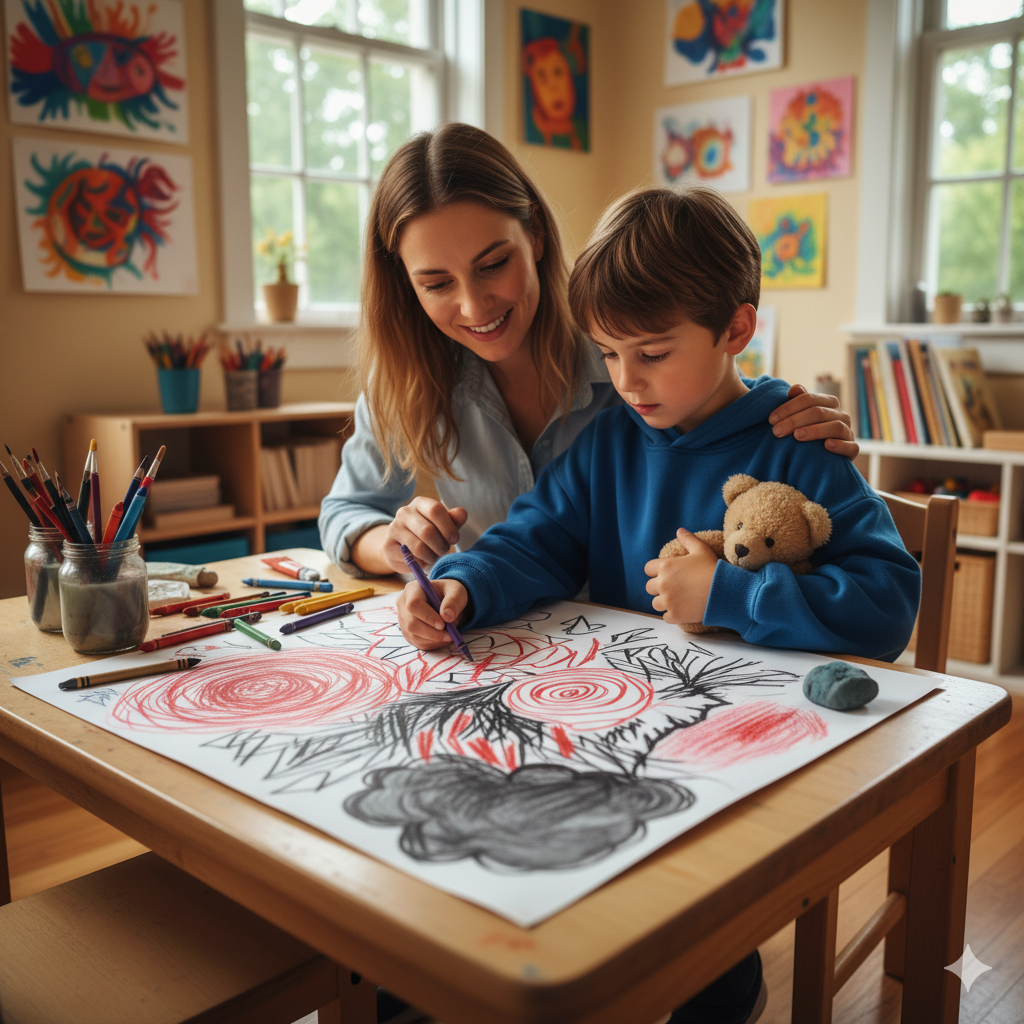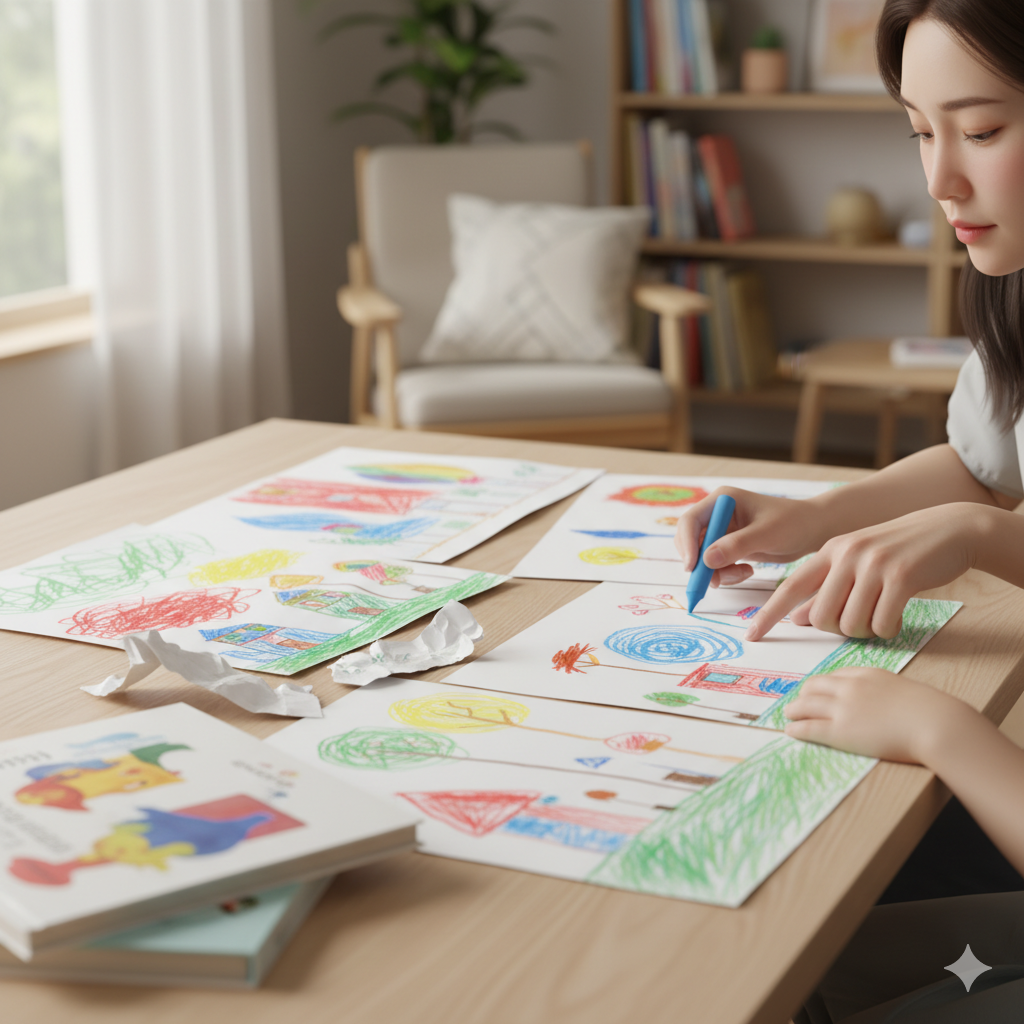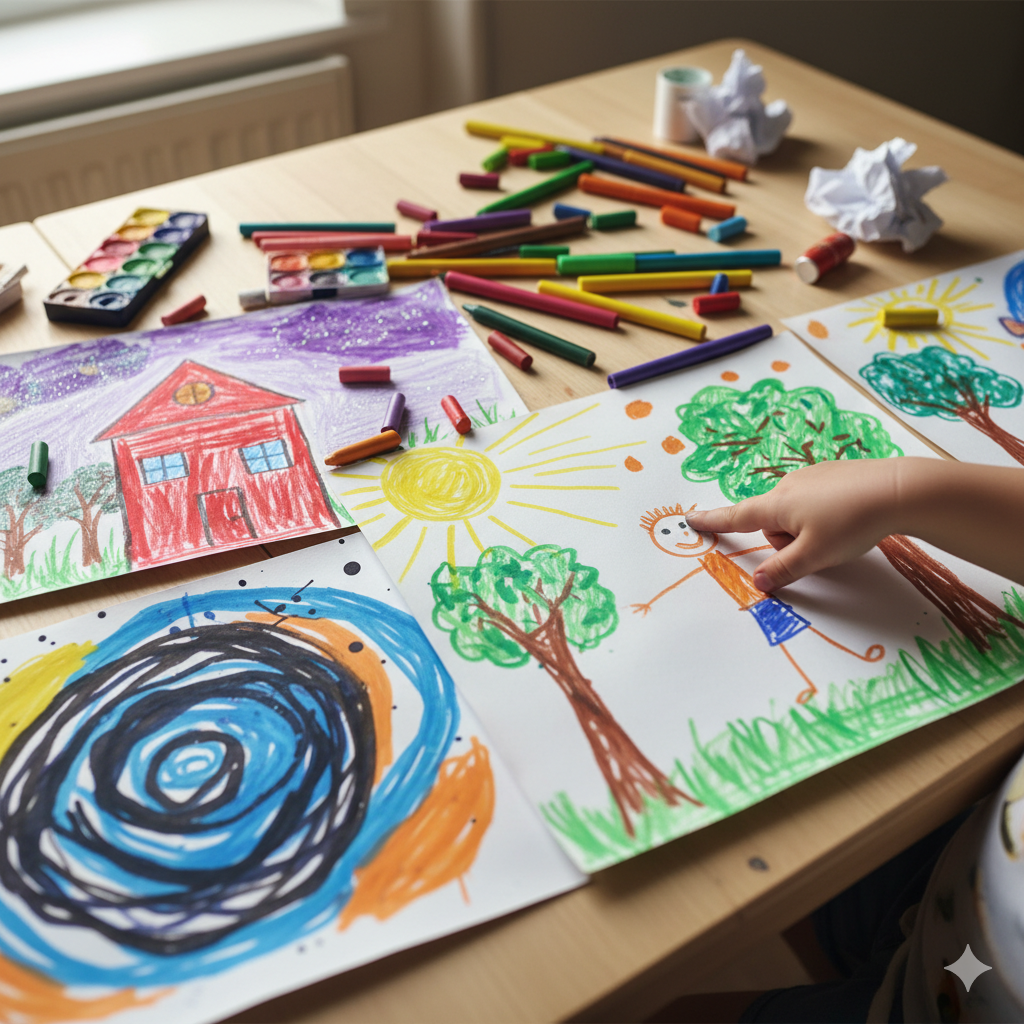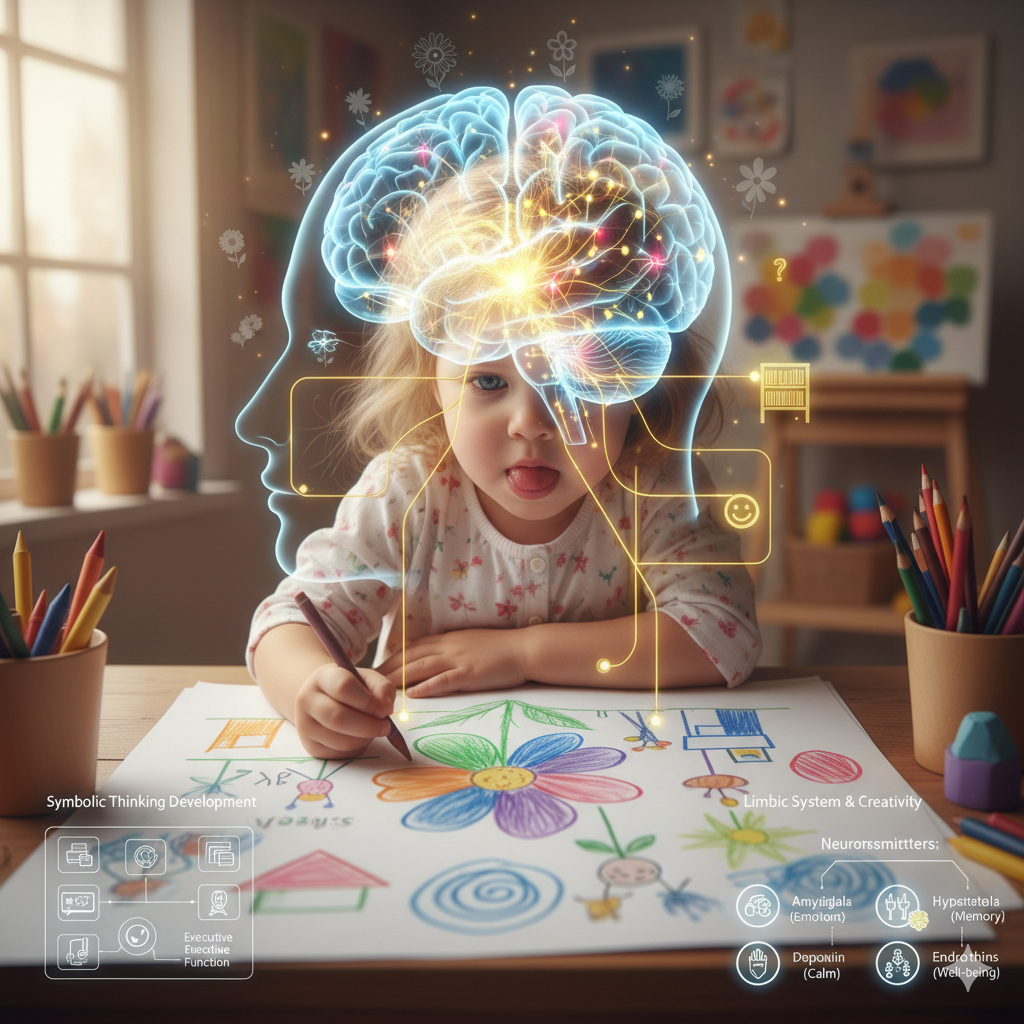How Art Therapy Helps Children Express Emotions
I remember the day my seven-year-old son came home from school, clearly upset but unable to tell me what was wrong. When I asked him to talk about it, he just shook his head and looked at the floor. But when I suggested we draw together, something magical happened. As his crayon moved across the paper, creating angry red lines and dark storm clouds, he began to process what had happened at school. By the time he finished his drawing, he was ready to tell me about the playground incident that had upset him.
Children experience a wide range of emotions as they navigate the complexities of growing up, but they often lack the vocabulary or confidence to express these feelings verbally. Art therapy provides a powerful alternative—a safe, nonverbal way for children to process, express, and understand their emotions through creative expression. This therapeutic approach has been proven effective in helping children of all ages work through emotional challenges and develop healthy coping mechanisms.
Understanding the Magic of Art Therapy
What Makes Art Therapy Special
Art therapy isn't just about making pretty pictures—it's about creating a bridge between a child's inner emotional world and their ability to communicate and process those feelings. For children, art provides something that words often can't: a way to communicate complex emotions without the pressure of finding the right words.
When my son was working through his anger through drawing, he was doing something remarkable. He was externalizing his internal experience, putting his abstract feelings into concrete form where he could see them, understand them, and eventually work through them. The red lines weren't just marks on paper—they were his anger being transformed into something he could manage.
The Healing Process in Action
The therapeutic process of art therapy is like watching a child learn a new language—the language of emotional expression. First, they create art using various materials and techniques, often without even realizing they're processing emotions. Then, through gentle guidance, they begin to reflect on the creative process itself.
I've watched my daughter paint her worries away, sculpt her fears into manageable shapes, and draw her way through difficult transitions. Each time, the art becomes a container for her emotions, allowing her to explore their meaning and eventually integrate new insights into her daily life.
The Science Behind Art Therapy
Neurological Benefits
Art therapy affects the brain in powerful ways:
Activation of the Right Hemisphere
Art therapy activates the right hemisphere of the brain, which handles emotional processing and creativity. This leads to visual-spatial thinking as the brain processes information through images, intuitive understanding by accessing subconscious emotional content, and holistic thinking that sees the big picture rather than details.
Stress Reduction
Art therapy promotes stress reduction through cortisol reduction as art-making decreases stress hormones, relaxation response through repetitive movements that promote calm, mindfulness by focusing on the present moment, and flow state through complete absorption in the creative process.
Neuroplasticity
Art therapy supports neuroplasticity by creating new neural pathways that develop new ways of thinking and feeling, emotional regulation by developing better control over emotions, resilience building through strengthening coping mechanisms, and trauma processing by working through difficult experiences safely.
Psychological Mechanisms
Symbolic Expression
Art therapy facilitates symbolic expression by providing safe distance as art creates emotional distance from difficult topics, symbolic representation by using images to represent complex feelings, externalization through putting internal experiences into external form, and objectification by making abstract emotions concrete and manageable.
Cathartic Release
Art therapy enables cathartic release through emotional discharge as children release pent-up feelings through art, tension relief through physical release via creative expression, energy transformation by converting negative energy into positive creation, and emotional cleansing through processing and releasing difficult emotions.
Common Emotional Challenges Art Therapy Addresses
Anxiety and Worry
Children with anxiety often benefit from art therapy:
How Art Helps:
Art helps with anxiety through focus and mindfulness as art-making requires present-moment attention, control and mastery since creating art gives children a sense of control, worry externalization by putting worries into visual form to make them manageable, and relaxation through repetitive art activities that promote calm.
Specific Techniques:
Specific techniques for anxiety include worry boxes for creating containers for anxious thoughts, breathing mandalas by drawing while practicing deep breathing, anxiety maps for visualizing worry patterns and triggers, and calm place drawings for creating safe, peaceful imaginary spaces.
Anger and Aggression
Art therapy provides healthy outlets for angry feelings:
How Art Helps:
Art helps with anger through safe expression by channeling aggression into creative energy, physical release through using large movements and strong colors, emotional regulation by learning to manage intense feelings, and problem-solving through finding creative solutions to conflicts.
Specific Techniques:
Specific techniques for anger include anger volcanoes for visualizing anger as a natural force, conflict resolution drawings for working through disagreements visually, strength symbols for creating images of personal power, and calm-down tools for designing personal relaxation strategies.
Grief and Loss
Art therapy helps children process loss and change:
How Art Helps:
Art helps with grief through memorial creation by honoring lost loved ones or experiences, emotional processing while working through complex feelings of loss, continuity by maintaining connection through creative expression, and hope building through creating images of future possibilities.
Specific Techniques:
Specific techniques for grief include memory books for preserving important memories and experiences, transformation art for showing how loss can lead to growth, support networks by drawing people and resources that help, and future visions for creating hope-filled images of the future.
Trauma and PTSD
Art therapy is particularly effective for trauma recovery:
How Art Helps:
Art helps with trauma through safe processing by working through trauma at a manageable pace, narrative reconstruction through creating new stories about experiences, empowerment by reclaiming control through creative expression, and integration by making sense of fragmented experiences.
Specific Techniques:
Specific techniques for trauma include trauma narratives for telling stories through visual means, safety planning by creating visual safety strategies, body mapping for connecting physical and emotional experiences, and resource development for building internal and external supports.
Depression and Low Mood
Art therapy can help lift children's spirits:
How Art Helps:
Art helps with depression through mood elevation as creating beauty can improve mood, achievement by completing art projects that build confidence, connection as art-making connects children to their creative selves, and hope through creating positive images that can inspire optimism.
Specific Techniques:
Specific techniques for depression include mood journals for tracking emotions through art, gratitude art by focusing on positive aspects of life, future self-portraits for imagining happier times ahead, and joy collections for creating visual reminders of happy moments.
Art Therapy Techniques for Different Ages
Preschoolers (Ages 3-5)
Focus Areas:
Preschoolers benefit from focus areas including basic emotional recognition for identifying and naming feelings, safe expression by learning that all feelings are okay, sensory exploration through using art materials to explore emotions, and play integration by combining art with play therapy.
Appropriate Techniques:
Appropriate techniques for preschoolers include finger painting for direct, sensory emotional expression, clay work through physical manipulation of emotions, color exploration by using colors to represent feelings, and simple storytelling for creating stories through art.
School-Age Children (Ages 6-12)
Focus Areas:
School-age children benefit from focus areas including emotional vocabulary for expanding feeling words, problem-solving by using art to work through challenges, social skills for understanding others' emotions, and coping strategies for developing healthy ways to manage feelings.
Appropriate Techniques:
Appropriate techniques for school-age children include comic strips for telling stories with beginning, middle, and end, mask making by exploring different aspects of identity, group murals for collaborative emotional expression, and art journals for ongoing emotional processing.
Adolescents (Ages 13-18)
Focus Areas:
Adolescents benefit from focus areas including identity exploration for understanding who they are, relationship dynamics by working through social challenges, future planning through creating visions for their lives, and independence by developing self-reliance and confidence.
Appropriate Techniques:
Appropriate techniques for adolescents include self-portraits for exploring identity and self-concept, vision boards by creating goals and aspirations, mixed media for complex, layered emotional expression, and digital art using technology for creative expression.
Creating an Art Therapy Environment at Home
Setting Up the Space
Physical Environment:
Create a physical environment with a quiet, comfortable space that's free from distractions, good lighting with natural light when possible, easy cleanup materials that are easy to clean up, and privacy so children feel safe to express themselves.
Emotional Environment:
Establish an emotional environment that's non-judgmental by accepting all artistic expression, supportive by encouraging exploration and experimentation, safe with no criticism or correction of artwork, and respectful by honoring children's creative choices.
Essential Materials
Basic Supplies:
Essential basic supplies include paper in various sizes and types, drawing materials like crayons, markers, and colored pencils, painting supplies including watercolors, brushes, and palettes, and modeling materials such as clay, play dough, and modeling clay.
Additional Tools:
Additional tools include collage materials like magazines, fabric, buttons, and other found objects, natural materials such as leaves, sticks, stones, and shells, recycled materials including cardboard, containers, and packaging, and digital options like tablets, drawing apps, and cameras.
Guidelines for Parents
Do:
When working with children, focus on process by celebrating the act of creating rather than the product, ask open questions like "Tell me about your picture" rather than "What is that?," respect privacy by not forcing children to share if they don't want to, and provide time by allowing children to work at their own pace.
Don't:
Avoid correcting or fixing by not telling children how to draw "better," don't interpret by assuming you know what the art means, don't rush by allowing children to take their time, and don't judge by accepting all artistic expression without criticism.
When to Seek Professional Art Therapy
Signs That Professional Help May Be Needed
Behavioral Indicators:
Seek professional help when you notice behavioral indicators including persistent emotional difficulties with ongoing struggles with mood or behavior, trauma symptoms showing signs of PTSD or trauma-related issues, social difficulties with problems involving peers or relationships, or academic problems related to school-related stress or challenges.
Artistic Indicators:
Artistic indicators that may warrant professional help include repetitive themes of drawing the same disturbing image repeatedly, regression where art skills seem to go backward, avoidance of refusing to engage with art materials, or concerning content where art suggests serious emotional distress.
Finding an Art Therapist
Qualifications to Look For:
When seeking an art therapist, look for qualifications including a licensed therapist with proper mental health credentials, art therapy training with specialized education in art therapy, experience with children and specific training in child development, and good rapport with someone your child connects with.
Questions to Ask:
Important questions to ask include: What is your training in art therapy? How do you work with children of my child's age? What can I expect from the therapy process? How will you involve me as a parent?
Integrating Art Therapy Principles at Home
Daily Art Practices
Morning Art:
Morning art practices include mood check-ins by drawing how they feel at the start of the day, goal setting through creating visual reminders of daily objectives, energy expression by using colors and movements to express energy levels, and gratitude practice by drawing things they're thankful for.
Evening Art:
Evening art practices include day reflection for processing the day's experiences through art, emotional release by letting go of stress and tension, problem-solving through working through challenges visually, and relaxation by using art as a calming bedtime routine.
Family Art Activities
Collaborative Projects:
Collaborative family art activities include family murals for creating art together about shared experiences, story creation by building stories through group art-making, memory books for preserving family memories through art, and vision boards by sharing hopes and dreams through visual means.
Individual Expression:
Individual expression opportunities include personal art journals for private spaces for individual expression, art sharing circles providing safe spaces to share artwork with family, art appreciation by learning to value each other's creative expression, and art celebrations for honoring creative achievements.
The Long-term Benefits of Art Therapy
Emotional Development
Benefits Include:
Long-term emotional development benefits include emotional intelligence with better understanding and management of feelings, empathy through increased ability to understand others' emotions, resilience with better ability to bounce back from challenges, and self-awareness through deeper understanding of their own emotional patterns.
Cognitive Development
Benefits Include:
Long-term cognitive development benefits include creative problem-solving for finding innovative solutions to challenges, focus and attention through improved ability to concentrate and stay on task, memory with enhanced ability to remember and process experiences, and flexibility through better ability to adapt to change and new situations.
Social Development
Benefits Include:
Long-term social development benefits include communication skills with better ability to express themselves, relationship building through improved ability to connect with others, conflict resolution for finding peaceful ways to resolve disagreements, and leadership through confidence in expressing ideas and taking initiative.
Physical Development
Benefits Include:
Long-term physical development benefits include fine motor skills with improved hand-eye coordination and dexterity, sensory integration through better processing of sensory information, stress reduction with lower levels of stress hormones, and relaxation through better ability to calm down and relax.
Conclusion
Art therapy offers children a powerful, safe, and effective way to process and express their emotions. Through creative expression, children can explore their inner world, work through challenges, and develop healthy coping mechanisms that will serve them throughout their lives.
The beauty of art therapy lies in its accessibility and effectiveness. You don't need to be an artist to benefit from artistic expression, and you don't need to have serious problems to find value in the therapeutic aspects of art-making. Every child can benefit from the emotional, cognitive, and social development that comes from regular creative expression.
Whether you're supporting your child's emotional development at home or seeking professional art therapy services, remember that the goal is not to create perfect artwork, but to provide a safe space for emotional exploration and expression. The process of creating art is just as important as the final product, and sometimes more so.
By understanding and supporting your child's emotional expression through art, you're giving them valuable tools for navigating the complexities of life with confidence, creativity, and emotional intelligence.
Want to explore how your child's artwork might be expressing their emotions? Our AI-powered analysis tool can provide insights into the emotional content, artistic expression, and developmental patterns in your child's drawings. Try our child drawing analysis tool to discover what your child's art might be telling you about their emotional world.
---
This article is for educational purposes only and should not replace professional therapy. If you have concerns about your child's emotional well-being, please consult with a qualified mental health professional.



